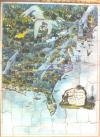Puzzles were first made in England in the 1760s using solid wood and hand-held fret saws. The limitations of materials and equipment kept the pieces large, the knobs (if any) large, and the cutting simple, usually straight or crooked lines. The market was primarily for children as learning tools (maps, tables of monarchs, history), morality lessons (bible, proverbs, fables), and, by the second half of the 19th century, simple family entertainment (national achievements, technology). By the turn of the century, a few “primitive” puzzles made for grown-ups in America began to appear and be promoted. The treadle scroll saw was used to cut most puzzles in the second half of the 19th century and into the 20th century when it was replaced by the electric scroll saw. An 1870s treadle model is on display. Over 20 of our 19th century puzzles have been donated to the American Antiquarian Society where they can be better preserved, studied and appreciated, leaving 2 for display here.
Wonderful pictorial map puzzle of early U.S., unusual for London map & puzzle makers who focused more on European maps for European audiences. States and territories cut along color lines. Hand colored, usually by small boys. Fascinating detail with an English view of early America.
Company was the leading 19th century color lithographer publishing prints celebrating achievements of America and cutting many into puzzles. Colorful graphics make its puzzles and boxes highly collectible today. Note the very large pieces, interlocking edges but non-interlocking center, characteristic of most puzzles from the very first made in 1760’s.

